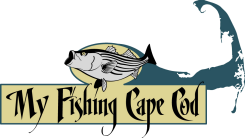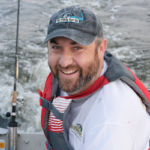Cape Cod Bay Stripers: Essential Tactics for Surf Casting Success in Challenging Conditions
The nor'easter currently sweeping through Cape Cod is providing challenging fishing conditions, but exceptional opportunities. Ian McPartland from Goose Hummock shop in Orleans recently had a 40 fish night from the beach inside Cape Cod Bay with fish upwards of 35 pounds.
Understanding Cape Cod Bay's Migratory Pattern
Cape Cod's unique geography creates two distinct migration routes for striped bass during their spring movement north. While some fish travel through the Cape Cod Canal, others take the longer route around Cape Cod, eventually settling into Cape Cod Bay. According to Ian's observations over the past three springs, the bay consistently attracts higher-quality fish compared to other areas.
This migration split means that Cape Cod Bay often becomes a holding area for larger, more mature stripers. The bay's structure and baitfish populations make it an ideal staging ground, particularly when weather conditions such as a nor'easter push bait against the shoreline. Understanding this pattern is crucial for timing your efforts and setting realistic expectations for the quality of fish you might encounter.
Wind as Your Ally: Fishing Northeast Conditions
While most anglers retreat indoors when northeast winds exceed 15 mph, experienced surf casters like Ian embrace these conditions. The key lies in understanding how wind affects both bait and predator behavior in Cape Cod Bay.
Northeast winds accomplish several things that benefit the surf angler:
Bait Concentration: Strong onshore winds push baitfish against the shoreline, creating concentrated feeding opportunities that stripers cannot resist. However, the lack of significant structure in much of Cape Cod Bay means that both bait and fish are constantly moving with the wind.
Increased Feeding Activity: Choppy conditions reduce the fish's ability to see clearly, making them more aggressive and less wary. This creates extended feeding windows, even during daylight hours.
Water Oxygenation: Wind-driven waves increase oxygen levels in the water, which can stimulate feeding behavior across the entire food chain.
The challenge lies in adapting your tactics to work with, rather than against, these blustery conditions. This means being prepared to move frequently and cover significant ground to stay with the fish.
Essential Lure Selection for Cape Cod Bay
Ian's success came from a carefully curated selection of lures that could handle both the casting demands and fishing capabilities required for nor'easter conditions:
Bucktails:
- Easy Release: The single hook design makes catch-and-release efforts much simpler and safer for both angler and fish.
- Versatile Presentation: Can be worked fast or slow, deep or shallow, depending on conditions.
- Wind Penetration: The compact design cuts through wind better than many other lures.
- Natural Action: The bucktail's movement closely mimics wounded baitfish.
Needle Fish:
The standout performer of Ian's stellar night inside Cape Cod Bay was a custom needle fish. The specific lure was a 3¼-ounce needle in a dark blue "blurple" color pattern. Several factors made this lure exceptionally effective:
- Weight and Aerodynamics: At 3¼ ounces, this needle fish provided the casting distance necessary to reach fish in the deeper water beyond the surf zone. When fishing into strong headwinds, having adequate weight becomes crucial for maintaining casting distance and accuracy.
- Color Selection: The dark blue coloration proved irresistible to the stripers, even when other needle fish patterns failed to produce. This suggests that color selection can be critical, even when fishing in low-light or choppy conditions.
- Shallow Water Performance: Despite its weight, the needle fish worked effectively in the increasingly shallow water as the tide dropped, demonstrating the versatility that makes these lures so valuable.
Pencil Poppers:
For Memorial Day weekend warriors facing continued rough conditions, Ian recommends distance-casting pencil poppers for daytime fishing. Cloudy, rainy, choppy conditions extend the typical feeding windows, making topwater action more viable throughout daylight hours.
- They create significant surface disturbance that fish can locate even in choppy water.
- The casting weight allows anglers to reach fish that might be holding further offshore.
- The erratic action mimics distressed baitfish struggling in rough conditions.
Tide Strategy and Timing
The dropping tide played a crucial role in the Ian's success. As water levels decreased, fish became concentrated in the remaining deeper channels and holes. This concentration effect, combined with the wind-driven bait, created ideal feeding conditions.
- Starting Position: Begin fishing in deeper water and follow the fish as they move with the receding water.
- Lure Selection: As water becomes shallower, switch to lures that work more effectively in skinny water.
- Safety Awareness: Be constantly aware of your exit route as water levels drop and walking conditions change especially in big surf.
Memorial Day Weekend
Despite challenging weather forecasts, several factors are aligning to create excellent fishing opportunities:
- Favorable Moon Phase: Past the full moon, conditions were more suitable for shore fishing.
- Reasonable Tide Times: Unlike some periods that require middle-of-the-night efforts, the tides offered accessible fishing windows.
- Stirred-Up Conditions: While water clarity might suffer, the increased activity often triggers aggressive feeding.
For Memorial Day weekend anglers, the key is embracing the conditions rather than fighting them. This means dressing appropriately, bringing adequate tackle, and being prepared to move when necessary.
Tight lines, take care, and thank you for listening!

